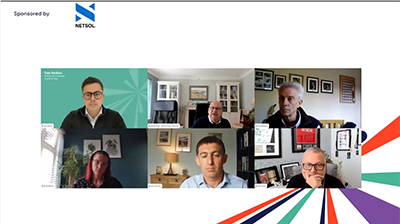
As a result of the pandemic, many people have become classed as vulnerable customers from a lending perspective. This has pushed the vulnerability guidelines and legislation set by the Financial Conduct Authority (FCA) to the forefront of lender’s minds. Now more than ever, there is a need to understand and overcome the barriers and challenges the industry is facing in dealing with vulnerable customers.
In an effort to reveal more about the topic, Asset Finance International sat down with Maria Fafouti (pictured above), who is a lead service designer focusing on behavioural change at Ernst & Young (EY) to discuss the existing biases in the credit decisioning process; ways in which lenders can better support vulnerable customers and the future of risk assessment in the finance industry.
Fafouti explained: “With the vulnerability agenda rising drastically in urgency, the FCA have done a great deal of policy work around treating vulnerable customers fairly and as a result many banks are changing their internal processes in order to align with this.
“Banks and finance companies must put the right checks in place to identify whether a customer is vulnerable and their key vulnerable characteristics, because they need to make sure that the treatment options they give to the customer are well-tailored for their situation. So, if they need a three-month forbearance that’s one option, if they need to pay a smaller amount that’s another option etc.
“Another requirement on lenders is to point the vulnerable customer in the direction of charities and other bodies that can help them with their situation. For instance, when a lender sends out a debt letter to a customer who is behind on their payments, they include the names of various debt management agencies.”
Next is now
Fafouti recently spoke at an International Asset Finance Network Online (IAFN Online) conference entitled ‘Next is Now: How human behaviour is changing and what this means for the customers of financial services today’.
In her presentation, she explained that bank managers have biases that are used to guide their financial behaviours. Individuals, irrespective of their job title and position, navigate the world around them through their biases. For instance, if a lender feels like they can trust the customer or even if they like the customer more, then can be more likely to offer more favourable pricing.
Fafouti said: “The first thing that I would point out is that the subjective reaction is automatic and an innate fact of human behaviour. You don’t choose to judge someone; it just happens straightaway through many verbal and non-verbal cues. This means that lenders can’t simply tell their employees to ‘stop being biased’. Ideally, people would be able to become aware of the judgment they made. However, many people don't acknowledge that they are doing this and even realising that they have made a judgment in the first place is difficult due to its unconscious nature.
"Instead, interventions can be put in place to protect the processes by ensuring that a broad range of objective measures are looked at together allowing someone to piece together the bigger picture more easily which would help them decide what the best course of action is."
“Interestingly enough, I have heard of examples where a customer might not have all the right finances but the lender’s staff could tell that the person was really passionate about what they're doing and was very knowledgeable, and so they gave the customer a favourable interest rate. Compared to someone who might have all the right numbers in the world, but they just seem very disengaged from their business.”
Is it your experience that lenders have many biases in their credit decisioning?
Fafouti added: “Our research points to a collection of biases that business owners and managers have which is simply because they're human beings. So, for instance if someone is feeling very overwhelmed with work then they don't always have the time to do the full due diligence process, they have to rely on these shortcuts. Of course checks are in place, but the way they ‘get to the answer’ may not be as stringent. There are variations, some people want to do things more by the books and put in the time, other people feel like they can rely more on their gut reaction.
“We tend to find that individuals who rely on those biases may not be optimizing the benefit that they could have. So, it's not necessarily an earth-shatteringly bad thing, it's just that they may not be making the best possible decision. In most cases, as long as you don’t make the wrong decision, you’re doing well enough.”
Fafouti also detailed that if an individual has worked in credit decisioning for a long time, they are more likely to mistake their biases for experience.
Furthermore, people with a lot of experience with this tend to be less willing to acknowledge their biases and change their behaviour or learn new styles of working. In comparison, younger employees are more likely to be more willing to learn and adapt the behaviours of their seniors or the company.
“So, if you run a company,” she said, “the best place to start is to make sure you instil the right behaviours in your staff very early on, because it gets harder and harder to influence as they got more senior.”
A big challenge
According to Fafouti, it is no longer enough for lenders to simply send a letter to a customer detailing how much money they owe; there must be more support offered and an effort made to tap-into their psychological reality.
Detailing a similar sentiment, one delegate at the IAFN Online event commented: “It’s such a pity that the consumer credit act requires us to issue letters in a certain prescribed way with wording which is very much outdated and which I consider quite threatening. We can always approach our customers separately using the lessons explained in today’s session however our written correspondence will remain as is unfortunately.”
This refers to the requirement by law to send two notices of sums in arrears; one after the account misses two payments and then again if the agreement remains in arrears for the first six months. At a time when many people are on payment holidays as a result of the pandemic, this requirement has forced many lenders to send a notice of sums in arrears and then a further letter explaining that in fact, the customer is not in arrears due to their payment holiday.
Fafouti continued: “This is a big challenge because even if a bank has an appetite to be softer on a vulnerable customer, the way the legislation works means that that it is much more difficult to practically show it. My suggestion would be to see if you can introduce new initiatives to support your customers in addition to the legislation; can you tweak the rest of the letter? For example, yes you have to include the key wording, but you can add other text to it as well or other visuals.
“Also, to the delegate’s comment on reaching out to customers individually, I don't think there's anything that would stop you from reaching out to them through letter form in order to provide support and with softer language. Given the FCA’s evolving perspective on protecting vulnerable customers, I think we're going to see a big demand for that to happen more often.”
Emotional barriers to repayment
In her talk at the IAFN Online event, Fafouti explained lenders should also look to their debt management partners to support their vulnerable customers.
She said: “Many lenders are becoming more aware of the importance of a debt management facility for their customers, and also some of the risks. For instance, vulnerable customers feel threatened when a management company contacts them. In response, some third-party organisations develop specific training and schemes to serve vulnerable customers, causing lenders to switch suppliers to them.
“However, there are several things that lenders should be doing to empathise more with their customers, understand them better and ensure that they’re receiving the most useful possible service. For instance, in addition to specialised processes, they need to have access to call recordings, insight to the necessary trainings and the emotional aspect that they need to specialise in to ensure a constructive conversation with the customer.
“Naturally when you're talking about people in debt, of course there will be a number of people who are not in a position to engage at all, but there is also a large number of people who don’t engage because of the large emotional barriers that they need to overcome. So, if you make it easier and extend your hand more to them it's a ‘no-regrets’ situation because the bank can still have in place the right risks and processes to make sure that when it is feasible to get the money they will and they don’t have to alienate the customer in order to do it.”
Assessing fraud vs vulnerability
Fafouti also pointed out that it shouldn’t be assumed that vulnerable customers don’t want to pay back their credit or that they’re a fraudulent customer. It’s more common that there’s simply so much happening in a customer’s life that they physically can’t organise everything that needs to happen in order to make the appropriate repayments.
She added: “If we want to change the perception of banks, we should work with customers with an open mind and give them the benefit of the doubt, at least in the first instance. You can have an open mind and the right ‘checks and balances’ in place. In most cases, vulnerable customers are not in this position because they want to be, perhaps the customer is a single parent of two who doesn’t earn a large enough income and is struggling to make ends meet.
“When a customer falls into debt, every bank that I’ve worked with will direct that customer to a debt management charity that will conduct the emotional conversation. However, the point of that conversation is still to guide the person to agree to some level of repayment that they can manage. This way, it’s not just a case of demanding a repayment with no regard for the negative effects on the customer.”
Furthermore, Fafouti delved into a more psychologically-framed topic whereby people tend to get overwhelmed by the potentially negative outcomes of their debt situation and begin to panic. As this happens, they tend to lose some of their higher-level thinking and fall into non beneficial behaviours such as avoidance. Interestingly, this is a similar reaction to the fight or flight response when dealing with fear.
“In terms of the fear response,” she said, “I think it’s more aimed towards the risk and danger involved. For example, the debt can represent the risk and danger which is why people typically approach it in two fairly extreme ways; either they get super organised and try to fix it or they get detached from it.
“For those who try to detach themselves from it, the main question is how can the lender help them to overcome those really intense feelings and help them to regain a sense of control / ownership over the situation?
“I’ve listened in on many debt calls and people can start crying, telling their life story etc. Some people have suffered through a lot which contributed greatly to the position they’re in now. The interesting thing about these phone calls is that the customer doesn’t always ask for the debt to be wiped clean, although there is a process for that in extreme cases. For most people it’s that feeling of helplessness that they need help since they don’t know where to begin with this long and emotionally complex process.”
How would you recommend a lender going about that?
Fafouti concluded: “The most basic thing that lenders can do is to give their frontline staff specific training to deal with those phone calls.
“Secondly, additional training around directing the conversation to a productive end, no matter how small the steps are for the customer. This works on the theory that in order to have a constructive conversation with the vulnerable customer, they need to be in the correct mental state.
“So, it can help to let the customer vent their feelings initially and then slowly direct the conversation to figuring out what they are able to do and breaking the actions down into smaller steps. Breaking the process down into smaller steps makes it far more achievable for the customer and greatly increases the lender’s likelihood of getting the debt repaid.”






